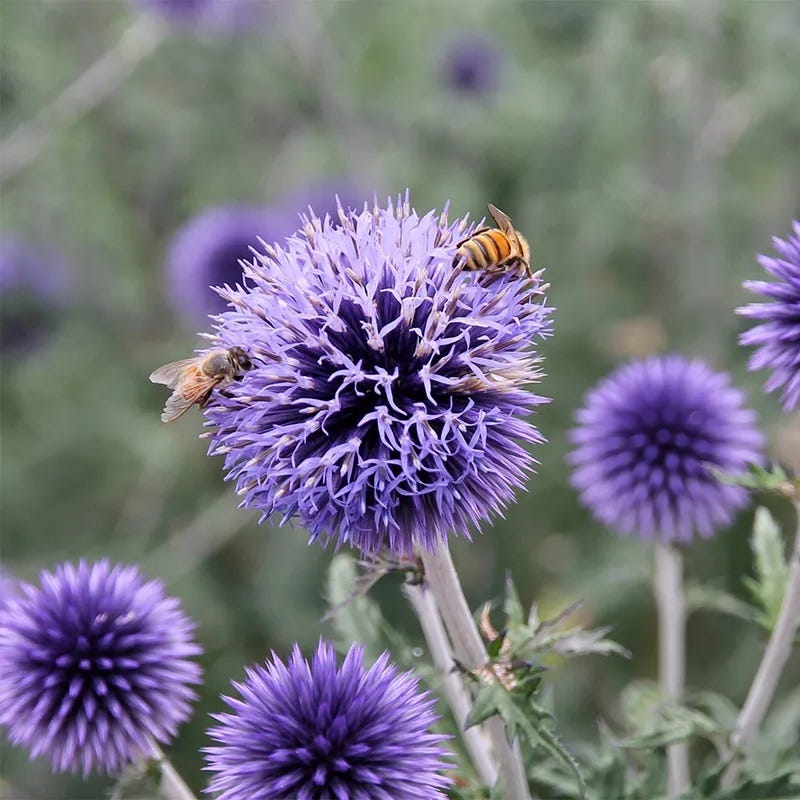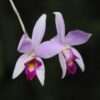Key Takeaways
- Globe thistles are known for their striking globe-shaped flowers and are great for ornamental use in gardens.
- These plants are drought-tolerant and thrive in well-drained soil with full sunlight exposure.
- While not toxic to humans, globe thistles can cause mild irritation in pets if ingested.
- They attract pollinators like bees and butterflies but are resistant to deer and rabbits.
- Globe thistles can spread rapidly through self-seeding, requiring careful management to prevent invasiveness.
Globe Thistle Overview
Globe thistles, scientifically known as Echinops, are captivating perennials that command attention with their unique spherical flower heads. These plants stand tall, typically reaching heights of 2 to 4 feet, and offer a striking visual in any garden setting. The flower heads, often in shades of blue, purple, or white, are about 2 inches in diameter and made up of numerous tiny star-shaped flowers. Their foliage is equally distinctive, with spiny, lobed leaves that add to their architectural appeal.
“Blue Glow Globe Thistle | Bee-Friendly …” from www.highcountrygardens.com and used with no modifications.
Botanical Characteristics and Appearance
The globe thistle’s most defining feature is its round flower head, which sits atop a sturdy stem. This plant’s stems and leaves are covered with fine hairs, giving it a slightly silvery appearance. The foliage is deeply lobed, often with a spiky texture that deters browsing animals like deer and rabbits. Despite their prickly demeanor, globe thistles are a favorite among gardeners for their easy care and ability to thrive in challenging conditions.
Native Habitats and Distribution
Globe thistles are native to regions of Europe and Asia, thriving in sunny, open habitats with well-drained soil. They have adapted well to various climates and are now found in gardens across the globe. Their ability to withstand drought and poor soil conditions makes them a resilient choice for gardeners looking to add a touch of drama to their landscapes.
In their natural habitats, globe thistles grow in rocky areas and dry meadows, where they benefit from full sun exposure and minimal competition from other plants. This adaptability to harsh environments is one of the reasons they have become popular in gardens worldwide.
Uses of Globe Thistle
Beyond their ornamental appeal, globe thistles offer a range of uses in both garden design and floral arrangements. Their striking form and long-lasting blooms make them a versatile addition to any landscape. For those interested in pet-friendly gardens, consider exploring pet-safe garden options that complement the beauty of globe thistles.
Ornamental Value and Applications
Globe thistles are often used to create visual interest in garden borders and beds. Their tall, spiky blooms add height and texture, making them an excellent choice for the back of a border or as a focal point in a mixed planting. They pair well with other drought-tolerant plants like lavender, yarrow, and coneflowers, creating a vibrant tapestry of color and form.
These plants also shine in wildlife gardens, where they attract a variety of pollinators. Their nectar-rich flowers are particularly appealing to bees and butterflies, making globe thistles an essential component of any butterfly-attracting garden.
Role in Floral Arrangements
The unique shape and color of globe thistle flowers make them a favorite among florists. They add a touch of whimsy and elegance to bouquets and arrangements, both fresh and dried. Their long stems and sturdy flower heads allow them to hold their shape and color for extended periods, making them ideal for dried floral crafts.
When used in floral arrangements, globe thistles complement a wide range of flowers, from delicate roses to bold sunflowers. Their silvery foliage and spiky texture provide contrast and interest, elevating the overall composition.
Caring for Globe Thistle
Globe thistles are relatively low-maintenance plants, making them an excellent choice for gardeners of all experience levels. With the right care and conditions, they will reward you with stunning blooms year after year.
Optimal Growing Conditions
To ensure your globe thistles thrive, plant them in a location that receives at least six hours of direct sunlight each day. These sun-loving plants need well-drained soil to prevent root rot, which can be a problem in heavy or poorly drained soils. Amending the soil with sand or gravel can help improve drainage if necessary. For more detailed information, you can refer to this globe thistle plant profile.
Globe thistles are hardy plants that can tolerate a range of soil pH levels, but they prefer slightly acidic to neutral conditions. Regularly testing your soil and making adjustments as needed will help keep your globe thistles healthy and vibrant.
Watering and Soil Recommendations
Once established, globe thistles are drought-tolerant and require minimal watering. During the first growing season, water them regularly to help their roots become established. After that, they will only need supplemental watering during prolonged dry spells.
Mulching around the base of the plants can help retain soil moisture and suppress weeds, reducing the need for frequent watering. Organic mulches like shredded bark or straw are ideal, as they will gradually break down and enrich the soil. For more information on plant care, you can visit The Spruce’s plant profile.
Flowering Season and Duration
Globe thistles are known for their vibrant and long-lasting blooms, which typically appear from mid to late summer. The flowering season can vary slightly depending on the climate and growing conditions, but you can generally expect to see blooms from July through September. These striking globes remain attractive for several weeks, providing color and interest well into the fall.
One of the key features of globe thistle blooms is their ability to retain their shape and color even as they begin to dry. This makes them a fantastic option for gardeners who want to enjoy the beauty of their garden throughout the changing seasons.
- Flowering period: July to September
- Bloom duration: Several weeks
- Color options: Blue, purple, and white
Because of their extended blooming period, globe thistles are a valuable addition to any garden, offering a continuous display of color and texture that complements other summer-blooming plants.
Besides that, their blooms can be left on the plant to dry naturally, providing structural interest in the garden during the winter months. If you prefer, you can also cut them for use in dried floral arrangements, where they will continue to shine long after the growing season has ended.
Impact of Environmental Factors on Bloom
Environmental factors play a significant role in the blooming success of globe thistles. Most importantly, ensuring your plants receive adequate sunlight is crucial. Without at least six hours of direct sunlight per day, globe thistles may produce fewer blooms or fail to flower altogether. For more information on sun-loving plants, check out our guide on pet-safe perennial sun care.
- Sunlight: At least six hours of direct sunlight daily
- Soil: Well-drained, slightly acidic to neutral pH
- Water: Minimal, avoid overwatering
Additionally, the soil quality can affect bloom production. Globe thistles prefer well-drained soil, as overly wet conditions can lead to root rot and negatively impact flowering. Amending your soil with organic matter or sand can improve drainage and help your globe thistles thrive. For more information on pet-safe plants, you might want to explore the care of crossandra flowers.
Therefore, monitoring environmental conditions and making necessary adjustments will help ensure your globe thistles produce the vibrant blooms they’re known for. If you notice a decline in flower production, consider evaluating your plants’ sun exposure and soil drainage to identify potential issues.
Dealing with Invasiveness
Globe thistles, while beautiful, can become invasive if not managed properly. Their ability to self-seed means they can quickly spread beyond their intended area, potentially crowding out other plants and altering the balance of your garden. To learn more about managing these plants, check out this globe thistle plant profile.
Understanding their growth habits and taking proactive steps can help you enjoy their beauty without worrying about unwanted spread. For those interested in pet-safe gardening, consider exploring pet-safe garden plants to complement your landscape.
Self-Seeding Characteristics
Globe thistles are prolific self-seeders, which means they can produce a large number of seeds that easily germinate and establish new plants. This characteristic can be both a blessing and a curse, depending on your gardening goals.
While self-seeding can lead to a lush, full garden without the need for additional planting, it can also result in overcrowding and competition for resources. To manage self-seeding, consider deadheading spent blooms before they have a chance to set seed.
Methods of Controlling Spread
There are several strategies you can employ to control the spread of globe thistles in your garden. One effective method is regular deadheading, which involves removing spent flowers before they produce seeds. This simple practice can significantly reduce the number of new plants that emerge each year.
Another approach is to create physical barriers, such as edging or mulching, to prevent seeds from spreading to unwanted areas. You can also consider planting globe thistles in containers or designated garden beds to contain their growth.
Potential Toxicity and Pets
While globe thistles are generally considered safe for humans, they can pose a mild risk to pets if ingested. The spiny foliage and stems can cause irritation to the mouth and digestive tract, leading to discomfort for curious pets who decide to take a bite. For more information on globe thistles, you can visit The Spruce’s plant profile.
It’s important for pet owners to be aware of these potential risks and take steps to protect their furry friends from accidental ingestion.
- Globe thistles are not highly toxic but can cause mild irritation.
- Keep pets away from the plants to prevent ingestion.
- Monitor pets for signs of irritation or discomfort.
In the event that your pet ingests part of a globe thistle plant, watch for symptoms such as drooling, vomiting, or pawing at the mouth. If you notice any of these signs, contact your veterinarian for guidance on how to proceed.
Toxicity to Humans and Common Pets
- Humans: Generally safe, but wear gloves when handling to avoid skin irritation.
- Cats and Dogs: May cause mild irritation if ingested.
- Rabbits and Rodents: Typically avoid due to spiny texture.
While globe thistles are not considered highly toxic, it’s always best to err on the side of caution and prevent pets from chewing on or ingesting plant material. By taking these precautions, you can enjoy the beauty of your globe thistles without compromising your pets’ safety.
Therefore, educating yourself and your family about the potential risks associated with globe thistles will help ensure a harmonious coexistence between your garden and your pets.
Interactions with Rabbits and Other Wildlife
Globe thistles are not only a delight for gardeners but also interact with various forms of wildlife. While they attract beneficial pollinators, they are generally unappealing to common garden pests like rabbits and deer.
Deer and Rabbit Resistance
One of the advantages of globe thistles is their natural resistance to deer and rabbits. The spiny texture of the leaves and stems makes them less palatable to these animals, who tend to avoid browsing on them.
This resistance makes globe thistles an excellent choice for gardeners who struggle with deer and rabbit issues. By incorporating globe thistles into your landscape, you can enjoy a more peaceful coexistence with these common garden visitors.
Attraction to Other Garden Wildlife
While deer and rabbits may steer clear of globe thistles, these plants are a magnet for beneficial insects and pollinators. Bees, butterflies, and other pollinators are drawn to the nectar-rich flowers, making globe thistles a valuable addition to any pollinator-friendly garden.
By providing a source of food for these important creatures, globe thistles help support biodiversity and contribute to a healthy ecosystem. Therefore, planting globe thistles not only enhances the beauty of your garden but also plays a role in promoting environmental sustainability.
Pollinator Attraction
Globe thistles are renowned for their ability to attract a wide variety of pollinators. Their unique flower structure, which consists of numerous tiny star-shaped blooms, is particularly appealing to bees and butterflies.
Pollinator-Friendly Features of Globe Thistle
The many small flowers that make up the globe thistle’s bloom are packed with nectar, providing a rich food source for pollinators. This abundance of nectar makes globe thistles an essential component of any garden designed to support pollinator populations.
Besides their nectar-rich flowers, globe thistles also offer a long blooming period, ensuring that pollinators have access to food throughout the summer months. By incorporating globe thistles into your garden, you can help support the health and vitality of local pollinator communities.
Enhancing Your Pollinator Garden
Creating a pollinator-friendly garden is a rewarding endeavor, and globe thistles are a fantastic addition to such a space. Their nectar-rich blooms are a favorite among bees and butterflies, providing them with essential nutrients throughout the summer. To maximize the benefits for pollinators, consider planting globe thistles alongside other nectar-rich plants like lavender, echinacea, and salvia. This combination not only enhances the visual appeal of your garden but also ensures a continuous supply of food for pollinators.
Comparison with Sea Holly and Other Thistles
Globe thistles often get compared to other thistle-like plants, such as sea holly and various other thistle species. While they share some similarities, there are distinct differences that set them apart. Understanding these differences can help you make informed decisions about which plants to include in your garden.
Similarities and Differences
Both globe thistles and sea holly are known for their unique, spiky blooms and drought tolerance. However, globe thistles tend to have a more spherical flower head, while sea holly features a more flattened, spiny flower with a central cone. Sea holly also often has a metallic blue hue, whereas globe thistles range from blue to purple and white. For those interested in exploring more about drought-tolerant plants, the African Daisy is another fascinating option to consider.
Another key difference is in their foliage. Globe thistles have spiny, lobed leaves, while sea holly leaves are often more deeply cut and have a glossy texture. These differences in appearance and texture can influence how each plant fits into your garden design.
Where Each Plant Excels in the Garden
Globe thistles excel in providing height and architectural interest in garden borders, making them ideal for adding structure to your landscape. Their ability to attract pollinators and resist deer and rabbits makes them a versatile choice for wildlife gardens.
Sea holly, on the other hand, is perfect for adding a touch of metallic color and unique texture to garden beds. Its striking appearance and drought tolerance make it a great option for xeriscaping and coastal gardens.
Conclusion on Growing Globe Thistle
Growing globe thistles in your garden can bring a host of benefits, from attracting pollinators to providing stunning visual interest. These hardy perennials are easy to care for, making them an excellent choice for gardeners of all skill levels.
Key Benefits for Gardeners
One of the main advantages of globe thistles is their drought tolerance. Once established, they require minimal watering, making them ideal for low-maintenance gardens. Their resistance to deer and wild rabbits also means you can enjoy their beauty without worrying about damage from these common garden pests.
Moreover, globe thistles are a valuable resource for pollinators, offering nectar and habitat for bees, butterflies, and other beneficial insects. By including them in your garden, you contribute to the health and diversity of local ecosystems.
Final Thoughts and Recommendations
Incorporating globe thistles into your garden can elevate its beauty and ecological value. To make the most of these stunning plants, ensure they are planted in well-drained soil with plenty of sunlight. Regular deadheading will help control their spread and encourage repeat blooming.
Example: “In my garden, I’ve found that pairing globe thistles with yarrow and lavender creates a beautiful, drought-tolerant display that attracts a plethora of pollinators.” – A satisfied gardener
Consider experimenting with different plant combinations to find what works best for your space and climate. With a little planning and care, globe thistles can become a standout feature in your garden.
Frequently Asked Questions (FAQ)
To help you get started with globe thistles, here are answers to some common questions:
Is globe thistle safe for pets?
While globe thistles are not highly toxic, they can cause mild irritation if ingested by pets. It’s best to keep pets away from these plants and monitor them for any signs of discomfort.
How do I prevent globe thistle from spreading?
Preventing the spread of globe thistles can be achieved through regular deadheading. Removing spent blooms before they set seed will significantly reduce self-seeding and help keep your garden tidy.
Additionally, consider using physical barriers or planting in containers to further control their growth.
What types of pollinators are attracted to globe thistle?
Globe thistles attract a variety of pollinators, including bees, butterflies, and other beneficial insects. Their nectar-rich flowers provide an important food source, supporting pollinator populations in your garden.
Example: “I’ve noticed an increase in butterfly visits since adding globe thistles to my garden. They seem to love the abundance of nectar!” – A pollinator enthusiast
By planting globe thistles, you can contribute to the health and diversity of your local ecosystem.
How does globe thistle compare to sea holly?
While both globe thistles and sea holly share similar drought-tolerant characteristics, they differ in appearance and preferred garden uses. Globe thistles are known for their spherical flower heads and spiny foliage, while sea holly features metallic blue, cone-shaped flowers and glossy leaves.
Example: “I love using both globe thistles and sea holly in my garden for their contrasting textures and colors. They complement each other beautifully!” – A creative gardener
Choosing between these plants depends on your garden design goals and personal preferences. For more information on globe thistles, check out this plant profile.
In conclusion, globe thistles are a valuable addition to any garden, offering beauty, ecological benefits, and resilience. With proper care and management, they can thrive in a variety of settings, enhancing your garden’s appeal and supporting local wildlife.





